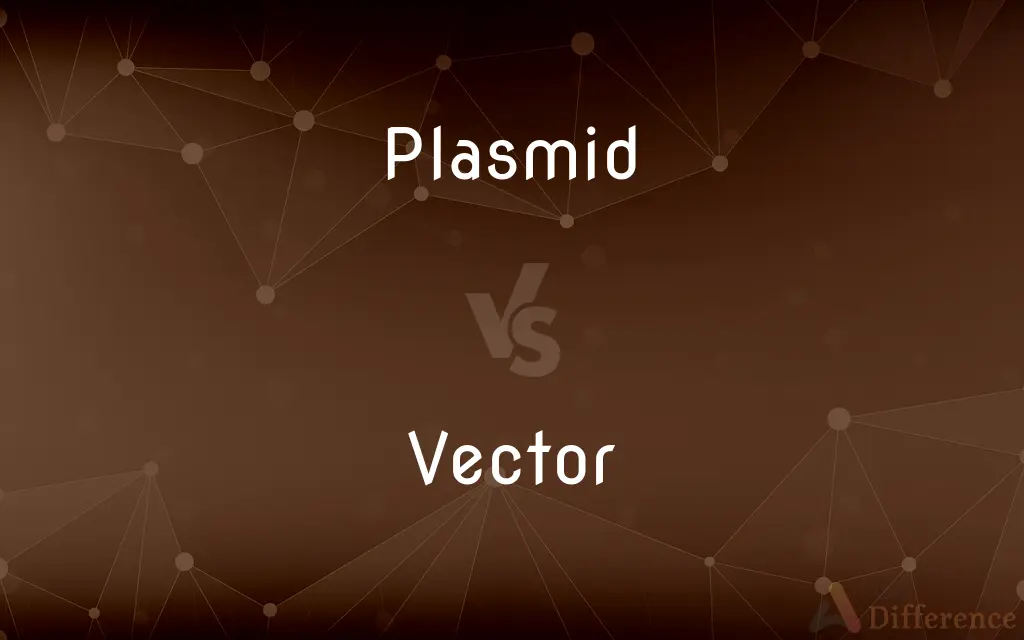Plasmid vs. Vector — What's the Difference?
By Urooj Arif & Fiza Rafique — Updated on March 16, 2024
Plasmids are naturally occurring, circular DNA molecules in bacteria, used in genetic engineering, while vectors are broader carriers (including plasmids) engineered to deliver DNA into host cells.

Difference Between Plasmid and Vector
Table of Contents
ADVERTISEMENT
Key Differences
Plasmids are small, circular, double-stranded DNA molecules found naturally in bacterial cells and some eukaryotes. They replicate independently of chromosomal DNA and often carry genes beneficial for bacterial survival, such as antibiotic resistance genes. On the other hand, vectors are tools in molecular biology designed to transport genetic material into a host cell, where plasmids serve as one type of vector, especially in genetic engineering and biotechnology applications.
While plasmids naturally occur and have been adapted for use in genetic manipulation due to their ability to autonomously replicate within host cells, vectors are specifically constructed or modified for research purposes. Vectors can include plasmids, viruses, artificial chromosomes, and other DNA sequences engineered to ensure the efficient insertion, expression, and replication of the genetic material they carry within different types of host cells.
The use of plasmids as vectors in genetic engineering involves inserting a gene of interest into the plasmid's DNA sequence, facilitating the study or manipulation of that gene. In contrast, vectors such as viral vectors are chosen for their ability to infect target cells and deliver genetic material with high efficiency, which is particularly useful in gene therapy and vaccine development.
Plasmids often contain a selectable marker, such as an antibiotic resistance gene, which allows for the identification and selection of cells that have successfully incorporated the plasmid. Meanwhile, vectors are designed with features that maximize their effectiveness in delivering and expressing genetic material in host cells, including promoters, origin of replication, and selection markers, tailored to their specific use.
While all plasmids can be considered vectors in the context of genetic engineering, not all vectors are plasmids. The choice between using a plasmid or another type of vector depends on the specific requirements of the genetic manipulation, such as the type of host cell, the size of the DNA to be inserted, and the need for gene expression control.
ADVERTISEMENT
Comparison Chart
Definition
Small, circular, independently replicating DNA molecules found in bacteria.
Carriers used to deliver genetic material into host cells, including plasmids.
Origin
Naturally occurring in bacteria and some eukaryotes.
Engineered or naturally occurring, modified for research purposes.
Usage
Can be used as vectors in genetic engineering.
Broadly used in biotechnology and medicine to introduce new DNA into host cells.
Types
Only plasmids.
Includes plasmids, viruses, artificial chromosomes, etc.
Application
Primarily in research and genetic manipulation within bacterial or simple eukaryotic systems.
Wide-ranging, including gene therapy, vaccine development, and functional genomics in various host cells.
Compare with Definitions
Plasmid
A small, circular, double-stranded DNA molecule that replicates independently of chromosomal DNA in bacteria.
Scientists used a plasmid to clone and express the gene of interest in bacterial cells.
Vector
A carrier molecule used to transfer genetic material into a host cell.
The gene therapy used a viral vector to deliver the therapeutic gene to patients' cells.
Plasmid
Can be transferred between bacteria through conjugation.
The antibiotic resistance plasmid was spread to other bacteria via conjugation.
Vector
Utilized in a variety of applications, from research to gene therapy.
Vectors are crucial tools in developing vaccines and studying gene function.
Plasmid
Contains features like origin of replication and selectable markers.
The plasmid vector has an ampicillin resistance gene as a selectable marker.
Vector
Engineered to ensure the efficient insertion and expression of genes in host cells.
This vector contains a strong promoter to drive the expression of the inserted gene.
Plasmid
Naturally occurs in bacteria, carrying genes that may benefit the survival of the host.
This bacterium's plasmid contains genes for antibiotic resistance.
Vector
Broadly includes plasmids, viruses, and artificial chromosomes.
Different vectors, such as plasmids and adenoviruses, are used depending on the target cells for gene transfer.
Plasmid
Used in genetic engineering as vectors.
A plasmid was chosen as the vector for introducing the recombinant DNA into the host cell.
Vector
Often contains selectable markers for identifying successful transformations.
Cells that were successfully transformed with the vector grew on the antibiotic-containing medium.
Plasmid
A plasmid is a small, extrachromosomal DNA molecule within a cell that is physically separated from chromosomal DNA and can replicate independently. They are most commonly found as small circular, double-stranded DNA molecules in bacteria; however, plasmids are sometimes present in archaea and eukaryotic organisms.
Vector
A quantity, such as velocity, completely specified by a magnitude and a direction.
Plasmid
A circular, double-stranded unit of DNA that replicates within a cell independently of the chromosomal DNA. Plasmids are most often found in bacteria and are used in recombinant DNA research to transfer genes between cells.
Vector
A one-dimensional array.
Plasmid
(cytology) A loop of double-stranded DNA that is separate from and replicates independently of the chromosomes, most commonly found in bacteria, but also in archaeans and eukaryotic cells, and used in genetic engineering as a vector for gene transfer.
Vector
An element of a vector space.
Plasmid
A piece of DNA, usually circular, functioning as part of the genetic material of a cell, not integrated with the chromosome and replicating independently of the chromosome, but transferred, like the chromosome, to subsequent generations of daughter cells. In bacteria, plasmids often carry the genes for antibiotic resistance; they are exploited in genetic engineering as the vehicles for introduction of extraneous DNA into cells, to alter the genetic makeup of the cell. The cells thus altered may produce desirable proteins which are extracted and used; in the case of genetically altered plant cells, the altered cells may grow into complete plants with changed properties, as for example, increased resistance to disease.
Vector
An organism, such as a mosquito or tick, that carries disease-causing microorganisms from one host to another.
Plasmid
A small cellular inclusion consisting of a ring of DNA that is not in a chromosome but is capable of autonomous replication
Vector
A bacteriophage, plasmid, or other agent that transfers genetic material from one cell to another.
Vector
A force or influence.
Vector
A course or direction, as of an airplane.
Vector
To guide (a pilot or aircraft, for example) by means of radio communication according to vectors.
Vector
(mathematics) A directed quantity, one with both magnitude and direction; the signed difference between two points.
Vector
(mathematics) An ordered tuple representing such.
Vector
(mathematics) Any member of a (generalized) vector space.
The vectors in are the single-variable polynomials with rational coefficients: one is .
Vector
(aviation) A chosen course or direction for motion, as of an aircraft.
Vector
(epidemiology) A carrier of a disease-causing agent.
Vector
(sociology) A person or entity that passes along an urban legend or other meme.
Vector
(psychology) A recurring psychosocial issue that stimulates growth and development in the personality.
Vector
The way in which the eyes are drawn across the visual text. The trail that a book cover can encourage the eyes to follow from certain objects to others.en
Vector
A memory address containing the address of a code entry point, usually one which is part of a table and often one that is dereferenced and jumped to during the execution of an interrupt.
Vector
(programming) A one-dimensional array.
Vector
A graphical representation using outlines; vector graphics.
A vector image, vector graphics
Vector
(molecular biology) A DNA molecule used to carry genetic information from one organism into another.
Vector
To set (particularly an aircraft) on a course toward a selected point.
Vector
(computing) To redirect to a vector, or code entry point.
Vector
Same as Radius vector.
Vector
A directed quantity, as a straight line, a force, or a velocity. Vectors are said to be equal when their directions are the same and their magnitudes equal. Cf. Scalar.
Vector
A variable quantity that can be resolved into components
Vector
A straight line segment whose length is magnitude and whose orientation in space is direction
Vector
Any agent (person or animal or microorganism) that carries and transmits a disease;
Mosquitos are vectors of malaria and yellow fever
Fleas are vectors of the plague
Aphids are transmitters of plant diseases
When medical scientists talk about vectors they are usually talking about insects
Common Curiosities
Can all vectors replicate independently like plasmids?
Not all vectors replicate independently; some rely on the host cell's machinery or specific sequences to ensure their replication and expression.
What is a plasmid?
A plasmid is a small, circular DNA molecule found in bacteria, capable of independent replication.
What is a vector in genetic engineering?
A vector is a carrier used to deliver genetic material into a host cell, which can be a plasmid, virus, or another DNA sequence.
What distinguishes a plasmid from other types of vectors?
Plasmids are naturally occurring and primarily used in bacteria, while other vectors, including viral vectors, are engineered for a broader range of host cells.
How do plasmids function as vectors?
Plasmids can be engineered to carry and introduce specific genes into host cells, taking advantage of their natural replication mechanisms.
Can vectors be used in human medicine?
Yes, vectors, especially viral vectors, are used in gene therapy, vaccine development, and treating genetic disorders.
How are vectors chosen for specific applications?
The choice depends on factors like the type of host cell, the size of DNA to be inserted, and the need for specific gene expression control.
Why are plasmids important in biotechnology?
Plasmids are essential for cloning, gene expression studies, and producing recombinant proteins, owing to their ease of manipulation and replication in host cells.
What are the key features of a vector?
Key features include an origin of replication, selectable markers, and promoters to control gene expression.
What role do selectable markers play in vectors?
Selectable markers, like antibiotic resistance genes, help identify cells that have successfully incorporated the vector.
Share Your Discovery

Previous Comparison
Bulgur vs. Couscous
Next Comparison
Voucher vs. InvoiceAuthor Spotlight
Written by
Urooj ArifUrooj is a skilled content writer at Ask Difference, known for her exceptional ability to simplify complex topics into engaging and informative content. With a passion for research and a flair for clear, concise writing, she consistently delivers articles that resonate with our diverse audience.
Co-written by
Fiza RafiqueFiza Rafique is a skilled content writer at AskDifference.com, where she meticulously refines and enhances written pieces. Drawing from her vast editorial expertise, Fiza ensures clarity, accuracy, and precision in every article. Passionate about language, she continually seeks to elevate the quality of content for readers worldwide.
















































